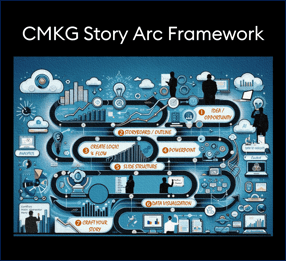Unlock the power of storytelling in business with CMKG's innovative Story Arc Framework. Learn how to captivate your audience and drive results through compelling narratives.
The Impact of Storytelling in Business
Transitioning to effective business storytelling through a structured framework has been a transformative journey for countless teams across various organizations. As an experienced trainer, I've had the privilege of guiding hundreds of individuals through this process, using the CMKG Story Arc Framework. This comprehensive approach has proven to be game-changing, enhancing not just one aspect of presentation skills, but fostering growth across multiple dimensions.
The power of using a storyboard, for instance, cannot be overstated. It allows individuals to visually map out their story, moving seamlessly from raw data to genuine insights. Learning how to craft compelling arguments with logical reasoning further ensures that the story not only captures attention but also holds it. Moreover, increasing proficiency in PowerPoint is crucial; it's not just about creating visually appealing slides, but making sure they effectively communicate the intended message.
I am deeply passionate about these learning areas as they embody crucial elements of developing compelling selling stories. There is little benefit in mastering data visualization without the ability to construct sound logic and flow, present robust insights and arguments, or consider the presentation from the audience's perspective. Without these elements, even the most visually appealing slides fail to resonate.
By adopting the CMKG Story Arc Framework, teams are equipped with the tools necessary to navigate the complexities of storytelling. This approach ensures that all aspects of a presentation are harmonized, transforming how teams communicate and significantly elevating their impact.
Let’s walk through this proven framework to understand how you can develop your storytelling abilities.
Understanding CMKG's Story Arc Framework

CMKG's Story Art Framework is an innovative approach to business storytelling that provides a structured framework for crafting compelling narratives. This framework consists of several key elements that work together to create a cohesive and impactful story.
Step 1: Identify an Opportunity or Idea
- Every great business story starts with a spark—an opportunity or an innovative idea tailored to address a specific need or problem. Identifying this foundation is crucial as it sets the direction and purpose of your narrative, ensuring that every element of your story is aligned and coherent.
Step 2: Create a Storyboard
- Once you have your foundational idea, the next step is to outline the key elements of your story using a storyboard. This visual tool allows you to organize thoughts, arrange content logically, and visualize the narrative flow. It’s important to consider your audience, main message, supporting details, and the connections between different parts of your story to ensure it's cohesive and compelling.
Step 3: Establish Logical Progression
- With your storyboard in place, the next task is to ensure your story unfolds logically. This progression from introduction to conclusion should be smooth, guiding the audience through your reasoning and maintaining their interest. The logical flow is critical for making your story easy to follow and engaging.
Step 4: Create a PowerPoint Outline
- After planning, it’s time to translate your storyboard into a structured PowerPoint outline. This outline isn’t just a list of bullet points; it should encapsulate all major points and subpoints, setting the stage for detailed content, visuals, and data that will later enrich your presentation.
Step 5: Design Slide Layout and Structure
- Change your slide titles to headlines that capture attention and concisely convey the key message of each slide. Designing the layout and structure carefully at this stage ensures that each slide contributes effectively to the story, with a clear objective that supports your overall narrative.
Step 6: Content and Visualization
- Before focusing on aesthetics, create content for each slide that aligns with its objective. Use data visualization to present information in a clear and compelling manner, selecting appropriate colors, visuals, and fonts to support your narrative and enhance understanding and engagement.
Step 7: Craft the Final Story
- Combine all planned content, data visualizations, and slide designs to finalize your business story. This last step is about refining and polishing, focusing on clarity, persuasiveness, and impact to ensure that your message not only resonates with your audience but also drives them to action.
Access Exclusive Resources and Take the Next Step
I challenge you to embark on a transformative journey using CMKG's Story Arc Framework to unlock the full potential of storytelling in your business. This framework not only harmonizes various presentation elements but significantly elevates communication impact across your team. If you're ready to captivate your audience and drive meaningful results through compelling narratives, we're here to guide you.
Plus, as part of our commitment to enhancing your skills, we're offering a free learning tool that dives deeper into the nuances of the CMKG Story Arc Framework. Click here to fill out the form and access the great learning tool:
I invite you to learn more about our tailored virtual training sessions, where your team will gain hands-on experience using your own data and examples. Contact me today to learn more about this opportunity and start transforming the way your team communicates. Your journey towards mastering powerful storytelling starts here.
Happy learning!
Sue


